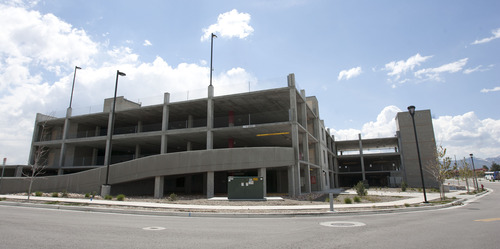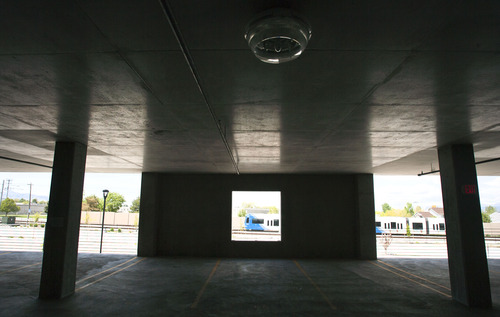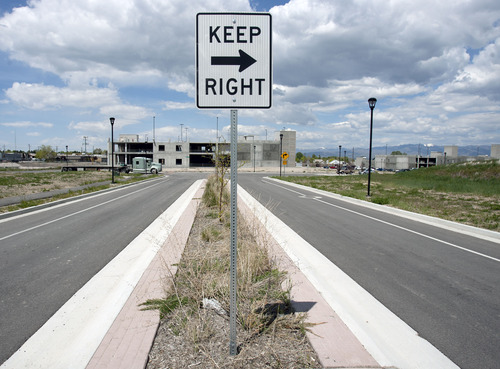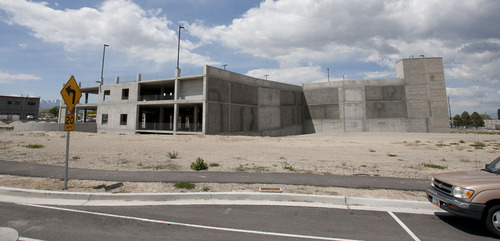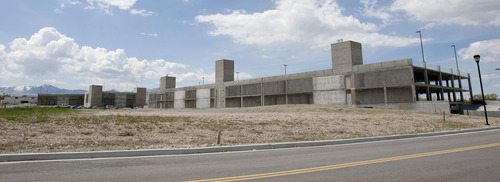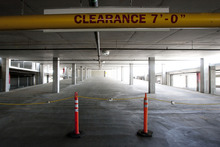This is an archived article that was published on sltrib.com in 2013, and information in the article may be outdated. It is provided only for personal research purposes and may not be reprinted.
West Jordan • On a recent weekday just before 5 p.m. — when you'd expect them to be most crowded before homeward-bound commuters start arriving — two large garages at the Jordan Valley TRAX station sit mostly empty. One of them has just 14 vehicles parked in it and the other is closed, with chains across its entrances.
The Utah Transit Authority, which built the structures at a cost of $15.56 million, has closed one garage and two of the four levels in its twin to save on maintenance costs.
That leaves 1,182 vacant stalls on this day 20 months after the Mid-Jordan section of the Red Line opened. UTA attempts to charge $1 a day to park there to help cover the maintenance — and even spent $106,000 for machines to collect it —but says just 16 to 20 motorists actually pay on a typical day. Twice that many use free street parking nearby.
Critics see the empty garages as monuments to waste at a time when UTA fares are among the highest in the nation, and the public agency has cut nighttime, weekend and other services to make ends meet. UTA defends the garages as sound long-term investments that should pay back big — eventually.
—
Investment • Steve Meyer, UTA's chief capital development officer, spreads out plans, cost estimates and drawings that he says show the garages are not multimillion-dollar blunders but part of a forward-looking project that makes financial sense.
"They were built as part of the mid-Jordan line," he says. That timing made them eligible for federal funding. If UTA had waited until later when demand for parking is projected to be higher, that federal money would not have been available. The garages are designed to meet projected parking needs for 2030, 19 years after the line opened.
The federal government paid $9.3 million of the garages' $15.56 million cost.
Meyer said an additional $3.9 million will be kicked in by developers who plan to break ground this fall on apartments that will wrap around and connect directly to the garages. UTA designed the garages figuring a fourth of the parking would go to such envisioned adjacent development.
Meyer says UTA will end up spending $2.33 million in local tax money on the garages.
Without the garages, Meyer said, UTA would have spent about $6 million on a surface parking lot anyway, with part of that eligible for federal money.
—
Development • Why even pursue the more expensive parking garages?
Meyer says they are key to making the site a model of what future high-density "transit-oriented development" may look like and be copied elsewhere.
Regional planners hope such developments may handle about a third of the Wasatch Front's expected 67 percent population growth expected by 2040. They envision town centers around transit stations that would have offices and retail businesses on the first floor, and residences above. People would live, work and play in the same area.
So UTA received permission from the Legislature to use land it owns at the Jordan Valley TRAX station (3400 West and 8600 South) and four others to serve as pilot projects.
"I think it is the epitome of the best planning practices," says Tom Burdett, West Jordan's community development director.
He praises UTA for buying extra land in order to help the development, adding that most parcels there had been foreclosed on by a bank so UTA likely picked them up for 30 percent less than current market value. Burdett said money also was saved on installing utilities for planned development at the same time that access roads and garages went in.
West Jordan fully endorsed the project only after nearby employers such as Fairchild and Jordan Valley Medical Center said they would benefit from development where employees could live within walking distance and "walk to dry cleaners or buy a meal and have services close by," Burdett said.
After a request for proposals, UTA chose Boulder Ventures Development as the developer. Meyer says its principals were involved in building the successful Jordan Landing shopping area nearby.
The planned "Bangerter Station" development will eventually have 1,400 dwellings, 32,000 feet of retail space and 80,000 feet of office space, Burdett says.
"We're so happy with plans that we are looking to something similar" at the West Jordan City Center TRAX station on Redwood Road, he adds.
—
Slowdown • Meyer acknowledges, though, that UTA expected more people to be using the station and garages by now. He says he gets inquiries regularly about the empty garages and jokes, "We probably would get even more calls, but not many people use the station — so they haven't noticed them [garages]."
The vacancies make the garages one of the few places that UTA offers long-term parking — and it has tried to promote them as an option for riders headed to Salt Lake City International Airport. The UTA board was told last week that the effort so far has attracted few, if any, additional cars.
Meyer also acknowledges that UTA originally thought development would happen long before now. "But the recession hit," he said. "That slowed things down, but it looks like it is getting back on track now."
—
Criticism • Watchdog Claire Geddes, a longtime vocal critic of UTA, sees the garages as a gamble with taxpayer money that UTA cannot afford.
"They are trying to act as super developers when they can't even get transit right," she said.
"Their fares are among the highest in the nation. They have cut services. Audits say they have dangerous amounts of debt. And what do they do? They spend $15 million on garages that no one is using. They should get back to basics," she said.
Geddes worries that something more nefarious than waste may be afoot and questions if UTA may be rewarding well-connected developers at taxpayer cost.
She notes that Boulder Ventures Development, UTA's choice for the Jordan Valley station, is owned by Jeff Vitek. He has had ties to developer Terry Diehl, a longtime UTA board member who was ousted amid questions of cozy deals with the agency.
A legislative audit asserted that Diehl violated state law by misusing official information about the location of a commuter rail station in Draper by buying rights to develop land around it.
Diehl sold his development rights to Vitek, and auditors later said Diehl made "millions" on it, although Diehl said he made little after covering his costs.
UTA Board Chairman Greg Hughes said the board pressured Diehl into resigning in May 2011 to stop him from continuing to develop land around transit stops while serving on the board. To convince Diehl to go, the board waived the usual yearlong ban on former board members from doing business with UTA.
Diehl has since acknowledged he was exploring development opportunities around transit stations.
Vitek did not immediately return phone calls for this story.
Geddes says questions need to be answered.
"Why are they out to help developers?" she asks of UTA. "What else could they have done with that money? Someone needs to reel them back to their basic mission."


